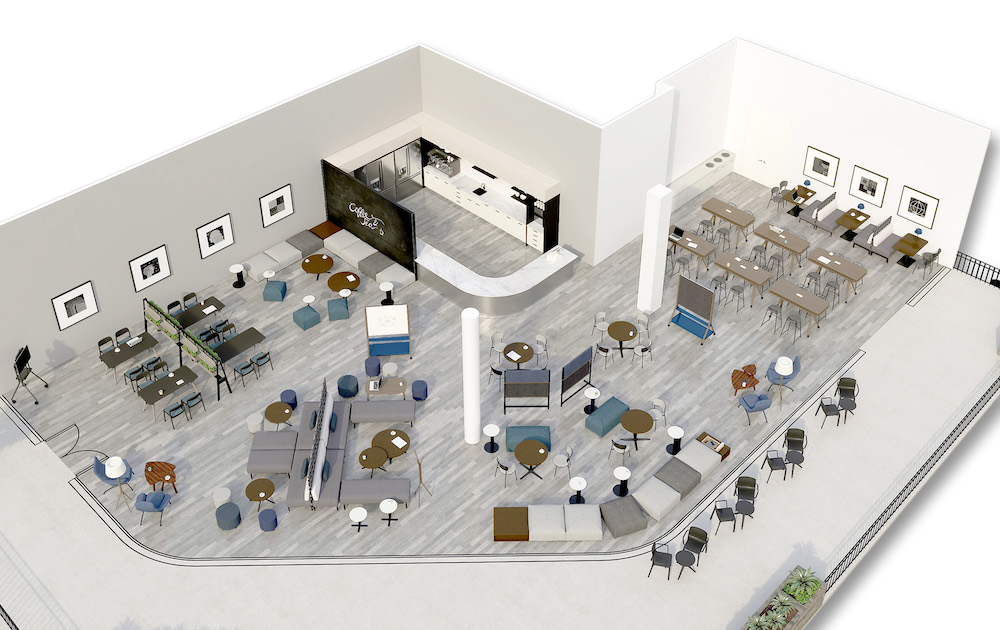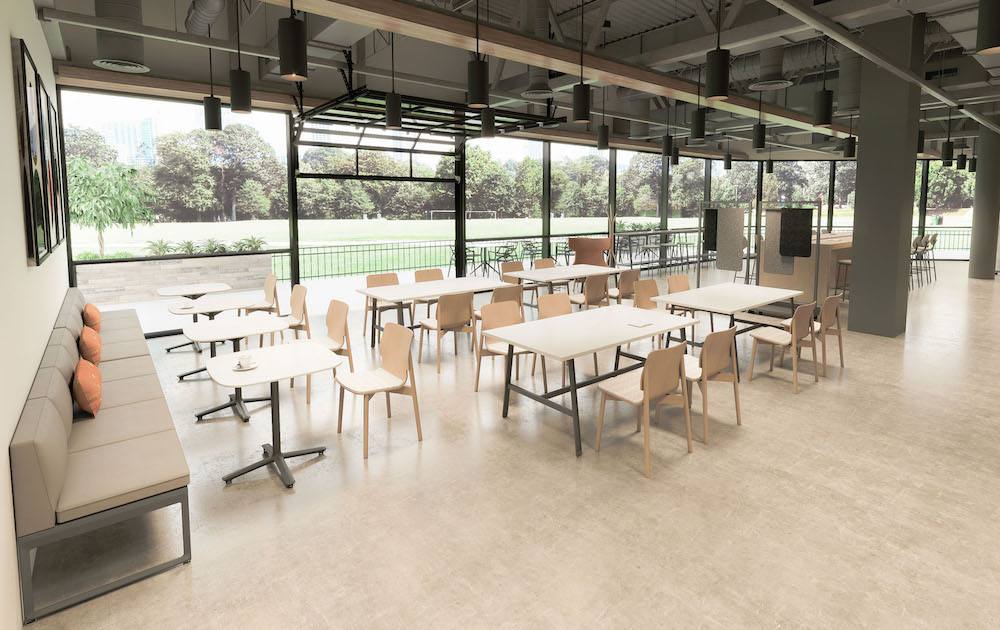Steve Delfino of Teknion explores the layout capabilities of the workplace cafeteria, as well as alternative uses for the space.
Once simply a way to provide a fast and safe way for workers to refuel, the workplace cafeteria has evolved to provide today’s workforce with not only a place to eat lunch but to gather, build culture, and exercise alternate workstyles. Reframing the idea of a cafeteria into an alternate workspace for relaxed collaboration ultimately transforms the use of the area, and either offers an additional workstation for those seeking a change of space or presents the 62% of workers who typically eat alone at their desks the opportunity to get more involved.
Looking at the varied uses for workplace cafeteria spaces within the office has been a recent shift in focus for workplace designers and furniture manufacturers. To further encourage the use of the space, designers are gravitating toward resimercial design. Analyzing how an enticingly-designed space can draw teams together, connect colleagues, and serve as a refreshing getaway at any time during the workday are key factors in developing a dynamic space for all. Understanding the layout capabilities of the workplace cafeteria also expands on previous thoughts of who uses the space, and how.
Reduced Stress and Increased Comfortability
It’s more efficient and cost-effective for employees to remain within the office environment for lunch because they’re increasing their actual time for eating by decreasing their amount of travel; therefore gaining back time while saving the travel fare. Not to mention that employee anxiety is reduced from not worrying about making it back to the office within a specific block of time. This returning practice allows for in-house cafeteria design to continuously progress at the same rate as office design itself. The easily accessible square footage allows teams needing a larger workspace or an individual needing alone time to function cohesively within different intentional sections of the same room, presenting the opportunity for workplace cafeteria spaces to be more useful outside of the lunch hour.
Technology has also had a widespread impact on the usefulness and design of cafeteria spaces. The increased ability for teams and individuals to work from anywhere automatically makes the cafeteria another gathering space to get work done.

Resimerical Influence in Office Design
A dedicated workplace cafeteria gives employees a less formal place to enjoy comforts reminiscent of home. Having a comfortable, inviting area away from desks or dedicated meeting spaces can encourage people to come together and unwind during break time. Curating an area mindful of the factors we love so much about our homes bridges the gap between a stuffy, professional landscape and soft, residential interiors, offering what we’ve come to understand as “ resimercial design. Themes of comfortability, safety, technological power at our fingertips, and even unlimited snacks at our disposal, influences how new and existing offices are currently being (re)decorated and (re)furnished.

During the return to office saga where some look forward to returning to the office, others want to remain at home or perhaps go to the office only two or three days a week. Having recently embraced the comforts of one’s remote workspace, adapting residential elements to develop commercial offices that also fit the needs of the employees will be crucial. Business leaders and designers agree that bringing people back to the office—five days a week or just three—requires thoughtful revisions to design and planning.
Research reveals that those who look forward to returning to work do so primarily for the opportunity to collaborate and socialize with peers. Thus, many companies are expanding the square footage allotted for shared spaces, creating a “third space” within the workplace (i.e. café-inspired environments with a mix of functional zones and furniture that supports dining, socializing, collaboration, and individual work).

Today’s worker craves options allowing for their individual personalities to shine. Cafeterias need to work hard to be fully operational as an alternative workspace. Not only is customizability important, but so is equipping these gathering spaces with all the tools—from technology to large work tables—to set up users for success.

Planning Styles Generated For Today’s Workforce
Modern workplace cafeterias have multiple functions to fill, with the ultimate goal of bringing people together including:
- Being accessible from a variety of spaces
- The ability to be used all day
- Easily transformable to fit varying needs
- Provide choice and create an experience that will motivate in-office employee attendance
Recognizing that different layout styles can be formatted for fixed and mobile, casual and formal work, an open cafeteria-sized space is a blank canvas for optimized work that effectively uses every square inch.

Casual-Mobile Layout
Use of casters and easily movable furniture provides full reconfigurability throughout the day. Sofas anchor the space, the tables can be moved together to form separate casual meeting spaces and the seating with casters can be nested if not required at certain times of the day.

Casual-Fixed Layout
Fixed elements combined with furniture that can still be moved, limiting transformation of the space to specific areas/items. The fixed furniture is planned at various heights allowing users to choose their experience. The same elements can be used for cafe settings then easily transform to meeting settings by pulling in whiteboards and TV stands.

Formal-Mobile Layout
Mobile tables with wood finishes create a formal cafe setting, but can be easily reconfigured and grouped to create large meeting or training spaces. Fixed banquet seating and lounge furniture in the area transforms from individual cafe settings to perimeter seating for meetings.

Formal-Fixed Layout
Mostly fixed furniture, the space is used with one intentional layout. Small changes can be made by pulling in a whiteboard between the tables to provide a level of functionality and privacy in a spontaneous meeting space. The perimeter sofas add additional seating in meeting scenarios.
Gathering In An Alternative Workspace
Reframing the idea of a workplace cafeteria into a gathering space for relaxed collaboration ultimately transforms the use of the area, and either offers an additional workstation for those seeking a change of space, or presents more independent workers the opportunity to feel more involved. Utilizing cafeterias as more than a place for eating lunch also offers the opportunity for more design freedom and comforting aspects from home to be infused throughout. Different planning styles and floor layouts with a variety of uses keep pace with growing employee expectations and also contribute to an overall positive user experience.


